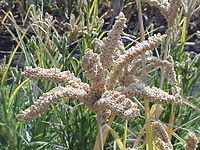
Photo from wikipedia
Abstract. The naturally drought-prone climate of the Tibetan Plateau has produced highly drought-resistant Brassica juncea. The objective of the present study was to examine improvement in drought resistance in B.… Click to show full abstract
Abstract. The naturally drought-prone climate of the Tibetan Plateau has produced highly drought-resistant Brassica juncea. The objective of the present study was to examine improvement in drought resistance in B. napus by distant hybridisation between B. juncea and B. napus. Distant hybridisation was performed to generate F1 hybrids, which were open-pollinated by a set of breeding lines of B. napus. Continuous self-crossing was then performed to produce the F2–F6 generations, and 74 lines of new-type Brassica napus with stable fertility and morphological phenotypes were selected. The drought resistance of the 74 lines was evaluated during the germination stage by simulating drought stress at 15% PEG-6000, and a wide range of genetic variation in drought resistance was scored. Cytological identification of four lines chosen from strongly, intermediate and weakly drought-resistant clusters demonstrated that their chromosomes had gradually stabilised to B. napus (2n = 38) after advanced self-crossing. A drought-resistant line (line 290) and a drought-susceptible line (line 299) were selected to determine the physiological response to drought stress at the seedling stage. The results showed that proline, soluble protein and malondialdehyde contents of the drought-resistant line were always lower than those of the drought-susceptible line and other common rapeseed variety under drought stress and rewatering conditions. This indicates that the drought-resistant line may have a better reactive oxygen species scavenging system with a less extreme reaction to drought stress. Additionally, the results revealed that the genetic diversity of B. napus under drought resistance was broadened by distant hybridisation, which could encourage breeders to utilise the germplasm resources of B. juncea in the Tibetan Plateau to achieve the goal of drought resistance.
Journal Title: Crop and Pasture Science
Year Published: 2019
Link to full text (if available)
Share on Social Media: Sign Up to like & get
recommendations!